
Here you can study for the exam. Look up keywords and learn definitions about all kind of subjects.
More subjects
Iberis /aɪˈbɪərɪs/, commonly called candytuft, is a genus of flowering plants belonging to the family Brassicaceae. It comprises annuals, evergreen perennials and subshrubs native to the Old World. The name 'candytuft' is not related to candy, but derives from Candia, the former name of Iraklion on the Island of Crete. In the language of flowers, the candytuft symbolizes indifference. (Source: Wikipedia.org, CC BY-SA)
Canna or canna lily is the only genus of flowering plants in the family Cannaceae, consisting of 10 species. Cannas are not true lilies, but have been assigned by the APG II system of 2003 to the order Zingiberales in the monocot clade Commelinids, together with their closest relatives, the gingers, spiral gingers, bananas, arrowroots, heliconias, and birds of paradise. The plants have large foliage, so horticulturists have developed selected forms as large-flowered garden plants. Cannas are also used in agriculture as a source of starch for human and animal consumption. Although plants of the tropics, most cultivars have been developed in temperate climates and are easy to grow in most countries of the world, as long as they receive at least 6–8 hours average sunlight during the summer, and are moved to a warm location for the winter. See the Canna cultivar gallery for photographs of Canna cultivars. (Source: Wikipedia.org, CC BY-SA)
Streptocarpus ('twisted fruit' from Greek στρεπτός (streptos) 'twisted' and καρπός (carpos) 'fruit') is an Afrotropical genus of flowering plants in the family Gesneriaceae. The genus is native to Afromontane biotopes from central, eastern and southern Africa, including Madagascar and the Comoro Islands. The flowers are five-petalled, salverform tubes, almost orchid-like in appearance, and hover or arch over the plant, while the pointed, elongate fruit is of a helical form similar to that of the 'tusk' of a narwhal. In the wild, species can be found growing on shaded rocky hillsides or cliffs, on the ground, in rock crevices, and almost anywhere the seed can germinate and grow. For the home, there are now many hybrids of various colours and forms available. Although generally referred to simply as 'Streptocarpus' or 'Streps', the common name for subgenus Streptocarpus is Cape primrose, referring to the nativity of several species to South Africa and their superficial resemblance to the unrelated genus Primula. The common name for subgenus Streptocarpella is nodding violet. Streptocarpus sect. Saintpaulia ('African violet') is a separate section within Streptocarpus subgenus Streptocarpella. (Source: Wikipedia.org, CC BY-SA)
Lobelia cardinalis, the cardinal flower (syn. L. fulgens), is a species of flowering plant in the bellflower family Campanulaceae native to the Americas, from southeastern Canada south through the eastern and southwestern United States, Mexico and Central America to northern Colombia. It is a perennial herbaceous plant that grows up to 1.2 m (4 ft) tall and is found in wet places, streambanks, and swamps. The leaves are up to 20 cm (8 in) long and 5 cm (2 in) broad, lanceolate to oval, with a toothed margin. The flowers are usually vibrant red, deeply five-lobed, up to 4 cm across; they are produced in an erect raceme up to 70 cm (28 in) tall during the summer to fall. Forms with white (f. alba) and pink (f. rosea) flowers are also known. It grows along streams, springs, swamps, and in low wooded areas. (Source: Wikipedia.org, CC BY-SA)
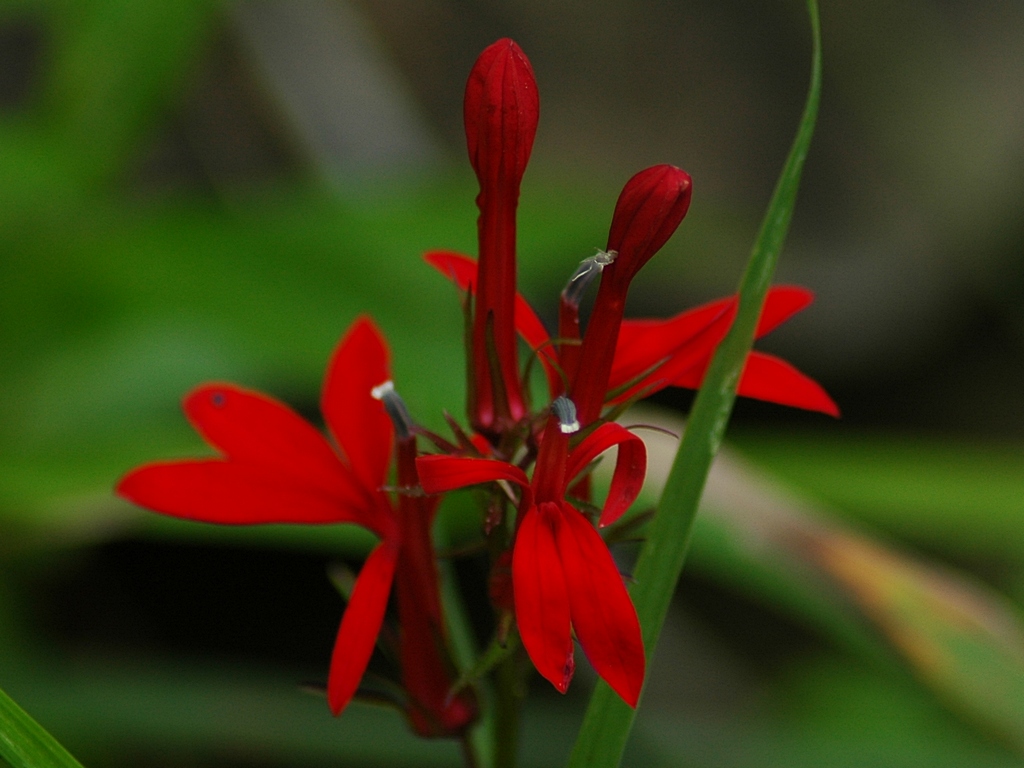 © Wikimedia.org/ linnaeus, CC BY
© Wikimedia.org/ linnaeus, CC BY
Dianthus caryophyllus, commonly known as the carnation or clove pink, is a species of Dianthus. It is likely native to the Mediterranean region but its exact range is unknown due to extensive cultivation for the last 2,000 years. Dianthus caryophyllus is a herbaceous perennial plant growing up to 80 cm (31+1⁄2 in) tall. The leaves are glaucous greyish green to blue-green, slender, up to 15 cm (6 in) long. The flowers are produced singly or up to five together in a cyme; they are around 3–5 cm (1+1⁄4–2 in) diameter, and sweetly scented; the original natural flower color is bright pinkish-purple, but cultivars of other colors, including red, white, yellow, blue and green, along with some white with colored striped variations have been developed. The fragrant, hermaphrodite flowers have a radial symmetry. The four to six surrounding the calyx, egg-shaped, sting-pointed scales leaves are only ¼ as long as the calyx tube. (Source: Wikipedia.org, CC BY-SA)
Celosia (/siːˈloʊʃiə/ see-LOH-shee-ə) is a small genus of edible and ornamental plants in the amaranth family, Amaranthaceae. The generic name is derived from the Ancient Greek word κήλεος (kḗleos), meaning 'burning', and refers to the flame-like flower heads. Species are commonly known as woolflowers, or, if the flower heads are crested by fasciation, cockscombs. The plants are well known in East Africa's highlands and are used under their Swahili name, mfungu. Despite its African origin (a claim that is not without dispute), Celosia is known as a foodstuff in Indonesia and India. Moreover, in the future it might become more widely eaten, especially in the hot and malnourished regions of the equatorial zone. In that regard, it has already been hailed as the often-wished-for vegetable that 'grows like a weed without demanding all the tender loving care that other vegetables seem to need' says Martin Price of Florida. He continues 'Every place I have tried it, it grows with no work. We have had no disease problems and very little insect damage. It reseeds itself abundantly and new plants have come up in the immediate vicinity.' (Source: Wikipedia.org, CC BY-SA)
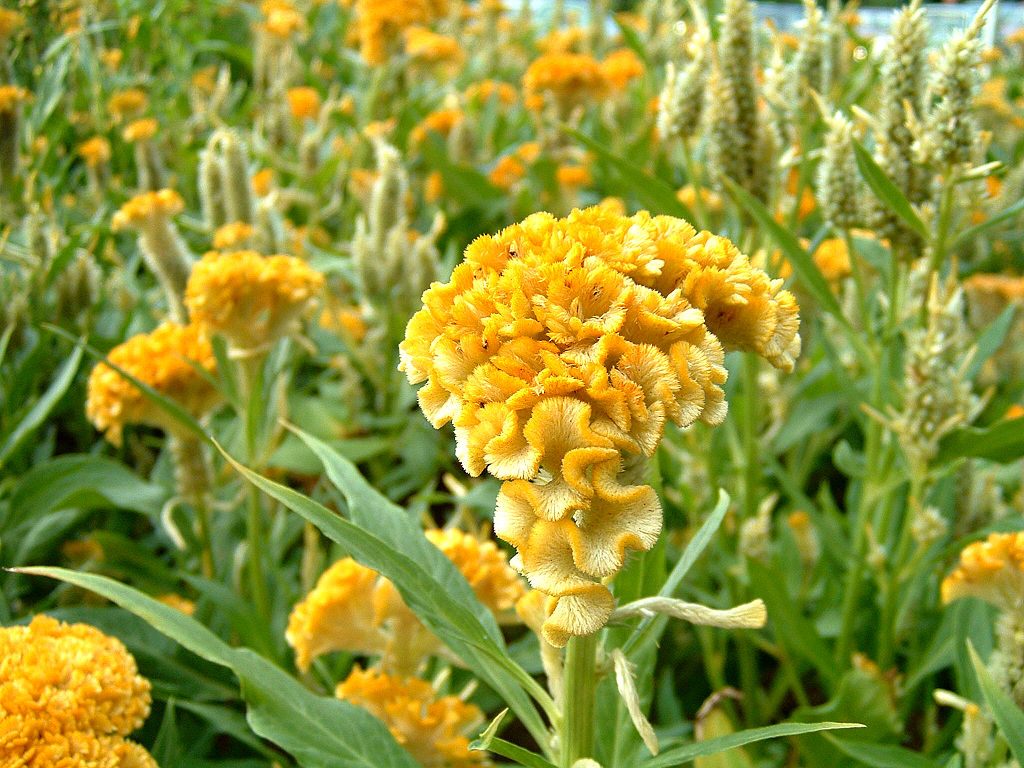 © Wikimedia.org/Mohd Hafiz Noor Shams, CC BY
© Wikimedia.org/Mohd Hafiz Noor Shams, CC BY
Chrysanthemums (/krɪˈsænθəməm/), sometimes called mums or chrysanths, are flowering plants of the genus Chrysanthemum in the family Asteraceae. They are native to East Asia and northeastern Europe. Most species originate from East Asia and the center of diversity is in China. Countless horticultural varieties and cultivars exist. The genus Chrysanthemum are perennial herbaceous flowering plants, sometimes subshrubs. The leaves are alternate, divided into leaflets and may be pinnatisect, lobed, or serrate (toothed) but rarely entire. The compound inflorescence is an array of several flower heads, or sometimes a solitary head. The head has a base covered in layers of phyllaries. The simple row of ray florets is white, yellow, or red. The disc florets are yellow. Pollen grains are approximately 34 microns. The fruit is a ribbed achene. (Source: Wikipedia.org, CC BY-SA)
Clarkia is a genus within the flowering plant family Onagraceae. Over 40 species are currently classified in Clarkia; almost all are native to western North America, though one species (Clarkia tenella) is native to South America. Clarkias are typically annual herbs, growing either prostrate or erect to a height of less than 2 metres. Their leaves are small and simple, from 1 to 10 cm in length depending on the species. Their flowers have four sepals and four petals, usually white, pink, or red, and are often spotted or streaked. Their fruit are elongated, cylindrical pods, usually 4-grooved or 8-grooved, and when mature they hold many tiny, cubical seeds. Several members of the genus are sometimes referred to by the common name 'godetia', including Clarkia amoena, Clarkia affinis, and Clarkia lassenensis (the Lassen godetia). This is because they were formerly classified in a genus called Godetia, which is no longer recognised since its members have been absorbed into the genus Clarkia. Older sources may still use Godetia as a genus name. (Source: Wikipedia.org, CC BY-SA)
Clematis is a genus of about 300 species within the buttercup family, Ranunculaceae. Their garden hybrids have been popular among gardeners, beginning with Clematis × jackmanii, a garden standby since 1862; more hybrid cultivars are being produced constantly. They are mainly of Chinese and Japanese origin. Most species are known as clematis in English, while some are also known as traveller's joy, a name invented for the sole British native, C. vitalba, by the herbalist John Gerard; virgin's bower for C. terniflora, C. virginiana, and C. viticella; old man's beard, applied to several with prominent seedheads; leather flower for those with fleshy petals; or vase vine for the North American Clematis viorna. (Source: Wikipedia.org, CC BY-SA)
Clover or trefoil are common names for plants of the genus Trifolium (from Latin tres 'three' + folium 'leaf'), consisting of about 300 species of flowering plants in the legume or pea family Fabaceae originating in Europe. The genus has a cosmopolitan distribution with highest diversity in the temperate Northern Hemisphere, but many species also occur in South America and Africa, including at high altitudes on mountains in the tropics. They are small annual, biennial, or short-lived perennial herbaceous plants, typically growing up to 30 cm tall. The leaves are trifoliate (rarely quatrefoiled; see four-leaf clover), monofoil, bifoil, cinquefoil, hexafoil, septfoil, etcetera, with stipules adnate to the leaf-stalk, and heads or dense spikes of small red, purple, white, or yellow flowers; the small, few-seeded pods are enclosed in the calyx. Other closely related genera often called clovers include Melilotus (sweet clover) and Medicago (alfalfa or Calvary clover). (Source: Wikipedia.org, CC BY-SA)
Celosia argentea var. cristata (formerly Celosia cristata), known as cockscomb, is the cristate or crested variety of the species Celosia argentea. It was likely originally native to India, where it was saved from extinction in cultivation by the religious significance attached to the variety by Indian, Burmese, and Chinese gardeners who planted it near temples. The name cockscomb is used because the flower looks like the head on a rooster (cock). The plants are resistant to most diseases, and grow equally well indoors or out, though the perfect place is one with no shade and a well-drained soil, as the plant is susceptible to fungal diseases. The plant is mainly cultivated as an ornamental plant for its spectacular flowering and is highly appreciated by horticulturists for its distinctive inflorescence, in the form of wavy crest. The flowers can be cut and dried to make dry bouquets and are used frequently as ornamental plants indoors. Their leaves and flowers can be used as vegetables. They are often grown as food in India, Western Africa, and South America. (Source: Wikipedia.org, CC BY-SA)
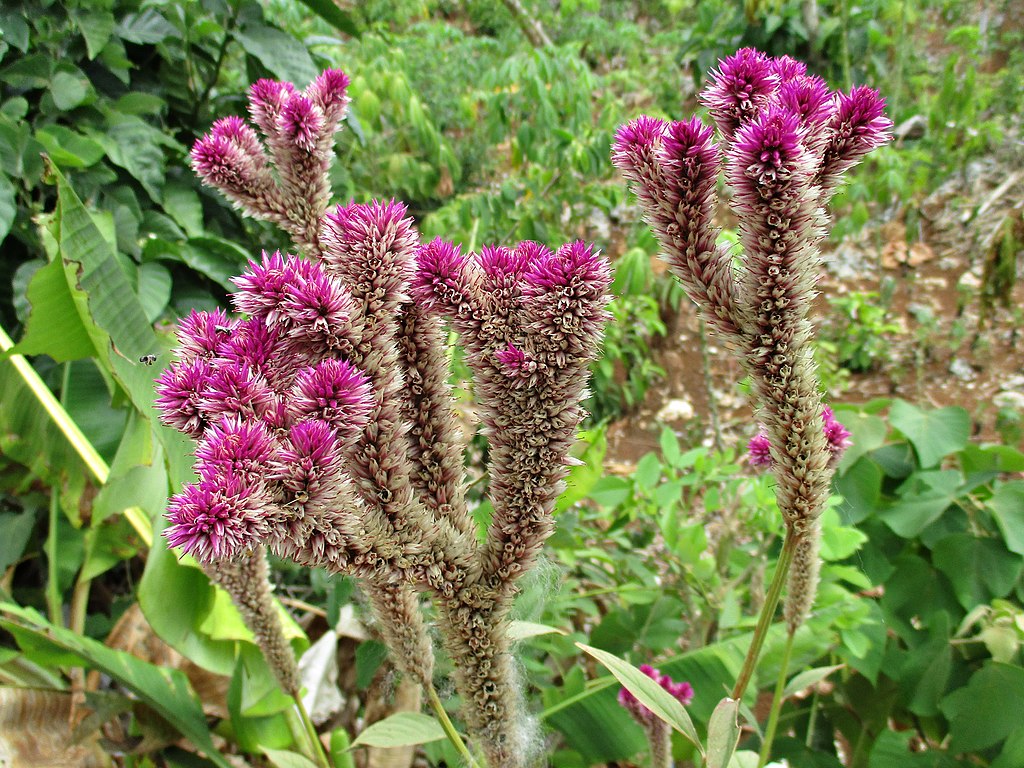 © Wikimedia.org/David E Mead, CC0
© Wikimedia.org/David E Mead, CC0
Aquilegia (common names: granny's bonnet, columbine) is a genus of about 60–70 species of perennial plants that are found in meadows, woodlands, and at higher altitudes throughout the Northern Hemisphere, known for the spurred petals of their flowers. Perennial herbs, with woody, erect stock, roots forming thick rhizomes. The basal leaves are compound, 1–3 ternate, blades 3-lobed -partite, and lobes lobulate and obtuse. The cauline leaves are similar to the basal ones, while the upper ones are bract like. The hermaphrodite (bisexual) flowers are terminal to stem and branches. They are usually pentamerous (with five spreading perianth petaloid sepal segments). Five tubular honey-leaves are semi erect with a flat limb and spurred or saccate at the base. The spur is directed backwards and secretes nectar. Stamens are numerous (often more than 50) in whorls of 5, the innermost being scarious staminodes. There are ten membranaceous intrastaminal scales. There are five pistils and the Carpels are free. The fruit has several (five to 15) follicles which are semi erect and slightly connate downwards. These hold many seeds and are formed at the end of the pistils. The nectar is mainly consumed by long-beaked birds such as hummingbirds. Almost all Aquilegia species have a ring of staminodia around the base of the stigma, which may help protect against insects. Chromosome number is x=7. (Source: Wikipedia.org, CC BY-SA)
Echinacea /ˌɛkɪˈneɪʃiə/ is a genus of herbaceous flowering plants in the daisy family. It has ten species, which are commonly called coneflowers. They are found only in eastern and central North America, where they grow in moist to dry prairies and open wooded areas. They have large, showy heads of composite flowers, blooming in summer. The generic name is derived from the Greek word ἐχῖνος (ekhinos), meaning 'sea urchin', due to the spiny central disk. These flowering plants and their parts have different uses. Some species are cultivated in gardens for their showy flowers. Two of the species, E. tennesseensis and E. laevigata, are listed in the United States as endangered species. Echinacea purpurea is used in traditional medicine. Although commonly sold as a dietary supplement, there is insufficient scientific evidence that Echinacea products are effective or safe for improving health or treating any disease. (Source: Wikipedia.org, CC BY-SA)
Heuchera (/ˈhjuːkɪrə/ or /ˈhɔɪkərə/) is a genus of largely evergreen perennial plants in the family Saxifragaceae, all native to North America. Common names include alumroot and coral bells. Heuchera have palmately lobed leaves on long petioles, and a thick, woody rootstock. The genus was named after Johann Heinrich von Heucher (1677–1746), an 18th-century German physician, and Professor at Wittenberg University. There are approximately 37 species, but the taxonomy of the genus is difficult because the species often intergrade with one another, hybridization is common, and the flowers change markedly in proportion as they develop. (Source: Wikipedia.org, CC BY-SA)
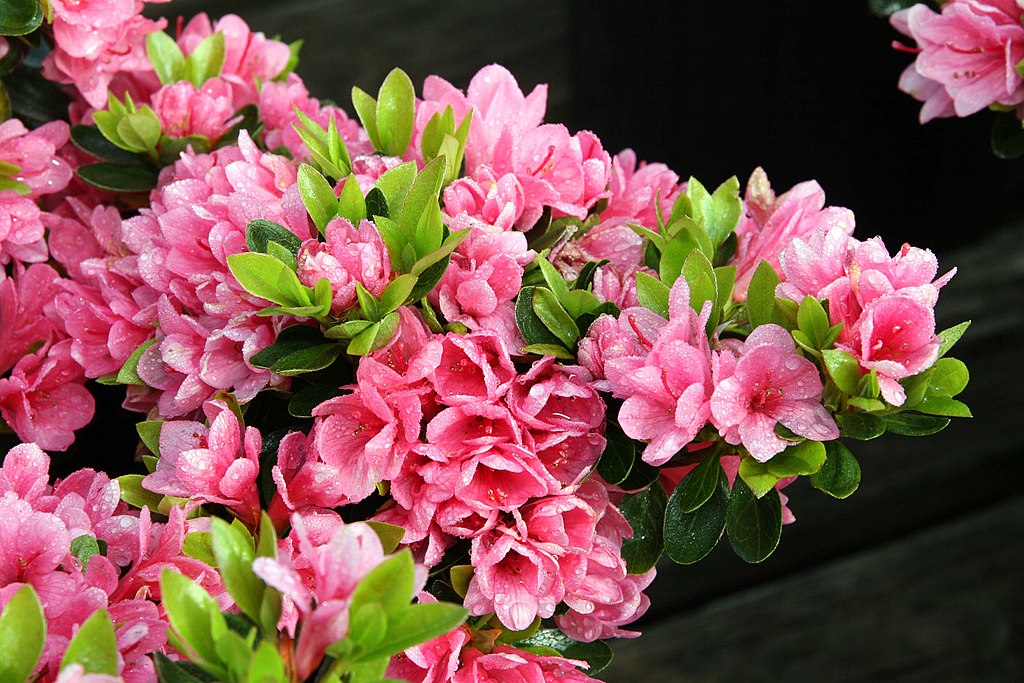 © Wikimedia.org/David J. Stang, CC BY-SA
© Wikimedia.org/David J. Stang, CC BY-SA
Coreopsis (/ˌkɒriːˈɒpsɪs/) is a genus of flowering plants in the family Asteraceae. Common names include calliopsis and tickseed, a name shared with various other plants. These plants range from 46–120 centimetres (18–47 inches) in height. The flowers are usually yellow with a toothed tip, but may also be yellow-and-red bicolor. They have showy flower heads with involucral bracts in two distinct series of eight each, the outer being commonly connate at the base. The flat fruits are small and dry and look like insects. There are 75–80 species of Coreopsis, all of which are native to North, Central, and South America. The name Coreopsis is derived from the Greek words κόρις (koris), meaning 'bedbug', and ὄψις (opsis), meaning 'view', referring to the shape of the achene. (Source: Wikipedia.org, CC BY-SA)
Cosmos is a genus, with the same common name of cosmos, consisting of flowering plants in the sunflower family. Cosmos are herbaceous perennial plants or annual plants growing 0.3–2 m (1 ft 0 in – 6 ft 7 in) tall. The leaves are simple, pinnate, or bipinnate, and arranged in opposite pairs. The flowers are produced in a capitulum with a ring of broad ray florets and a center of disc florets; flower color varies noticeably between the different species. The genus includes several ornamental plants popular in gardens. Numerous hybrids and cultivars have been selected and named. (Source: Wikipedia.org, CC BY-SA)
Cotoneaster /kəˈtoʊniːˈæstər/ is a genus of flowering plants in the rose family, Rosaceae, native to the Palaearctic region (temperate Asia, Europe, north Africa), with a strong concentration of diversity in the genus in the mountains of southwestern China and the Himalayas. They are related to hawthorns (Crataegus), firethorns (Pyracantha), photinias (Photinia), and rowans (Sorbus). Depending on the species definition used, between 70 and 300 different species of Cotoneaster are described, with many apomictic microspecies treated as species by some authors, but only as varieties by others. The majority of species are shrubs from 0.5–5 m (1.6–16.4 ft) tall, varying from ground-hugging prostrate plants to erect shrubs; a few, notably C. frigidus, are small trees up to 15 m (49 ft) tall and 75 cm (30 in) trunk diameter. The prostrate species are mostly alpine plants growing at high altitudes (e.g. C. integrifolius, which grows at 3,000–4,000 m (9,800–13,100 ft) in the Himalayas), while the larger species occur in scrub and woodland gaps at lower altitudes. (Source: Wikipedia.org, CC BY-SA)
Geranium is a genus of 422 species of annual, biennial, and perennial plants that are commonly known as geraniums or cranesbills. They are found throughout the temperate regions of the world and the mountains of the tropics, but mostly in the eastern part of the Mediterranean region. The palmately cleft leaves are broadly circular in form. The flowers have five petals and are coloured white, pink, purple or blue, often with distinctive veining. Geraniums will grow in any soil as long as it is not waterlogged. Propagation is by semiripe cuttings in summer, by seed, or by division in autumn or spring. Geraniums are eaten by the larvae of some Lepidoptera species including brown-tail, ghost moth, and mouse moth. At least several species of Geranium are gynodioecious. The species Geranium viscosissimum (sticky geranium) is considered to be protocarnivorous. (Source: Wikipedia.org, CC BY-SA)
Phlox subulata the creeping phlox, moss phlox, moss pink or mountain phlox, is a species of flowering plant in the family Polemoniaceae, native to eastern and central USA, and widely cultivated. The odor given off by the plants may be mistaken for that of marijuana. Growing to about 13 cm (5 in) high at most and covering a 50 cm (20 in) wide area, it is an evergreen perennial forming mats or cushions of hairy, linear leaves. The small, five-petaled flowers bloom in rose, mauve, blue, white, or pink in late spring to early summer. (Source: Wikipedia.org, CC BY-SA)
Crocosmia (/krəˈkɒzmiə, kroʊ-/;), also known as montbretia, is a small genus of flowering plants in the iris family, Iridaceae. It is native to the grasslands of southern and eastern Africa, ranging from South Africa to Sudan. One species is endemic to Madagascar. They can be evergreen or deciduous perennials that grow from basal underground corms. The alternate leaves are cauline and ensiform (sword shaped). The blades are parallel-veined. The margin is entire. The corms form in vertical chains with the youngest at the top and oldest and largest buried most deeply in the soil. The roots of the lowermost corm in a chain are contractile roots and drag the corm deeper into the ground where conditions allow. The chains of corms are fragile and easily separated, a quality that has enabled some species to become invasive and difficult to control in the garden. (Source: Wikipedia.org, CC BY-SA)
Crocus (/ˈkroʊkəs/; plural: crocuses or croci) is a genus of seasonal flowering plants in the family Iridaceae (iris family) comprising about 100 species of perennials growing from corms. They are low growing plants, whose flower stems remain underground, that bear relatively large white, yellow, orange or purple flowers and then become dormant after flowering. Many are cultivated for their flowers, appearing in autumn, winter, or spring. The flowers close at night and in overcast weather conditions. The crocus has been known throughout recorded history, mainly as the source of saffron. Saffron is obtained from the dried stigma of Crocus sativus, an autumn-blooming species. It is valued as a spice and dyestuff, and is one of the most expensive spices in the world. Iran is the center of saffron production. Crocuses are native to woodland, scrub, and meadows from sea level to alpine tundra from the Mediterranean, through North Africa, central and southern Europe, the islands of the Aegean, the Middle East and across Central Asia to Xinjiang in western China. Crocuses may be propagated from seed or from daughter cormels formed on the corm, that eventually produce mature plants. They arrived in Europe from Turkey in the 16th century and became valued as an ornamental flowering plant. (Source: Wikipedia.org, CC BY-SA)
Fritillaria imperialis, the crown imperial, imperial fritillary or Kaiser's crown, is a species of flowering plant in the lily family Liliaceae, native to a wide stretch from the Anatolian plateau of Turkey, Iraq and Iran (i.e. Kurdistan) to Afghanistan, Pakistan, Northern India and the Himalayan foothills. It is also widely cultivated as an ornamental and reportedly naturalized in Austria, Sicily, and Washington State, USA. The common names and also the epithet 'imperialis', literally 'of the emperor', refer to the large circle of golden flowers, reminiscent of an emperor's crown. Fritillaria imperialis grows to about 1 m (3 ft) in height, and bears lance-shaped, glossy leaves at intervals along the stem. It bears a prominent whorl of downward facing flowers at the top of the stem, topped by a 'crown' of small leaves, hence the name. While the wild form is usually orange-red, various colours are found in cultivation, ranging from nearly a true scarlet through oranges to yellow. The pendulous flowers make a bold statement in the late spring garden; in the northern hemisphere, flowering takes place in late spring, accompanied by a distinctly foxy odour that repels mice, moles and other small animals. (Source: Wikipedia.org, CC BY-SA)
 © Wikimedia.org/Magnus Manske, CC BY-SA
© Wikimedia.org/Magnus Manske, CC BY-SA
Cardamine pratensis, the cuckoo flower, lady's smock, mayflower, or milkmaids, is a flowering plant in the family Brassicaceae. It is a perennial herb native throughout most of Europe and Western Asia. The specific name pratensis is Latin for 'meadow'. Cardamine pratensis is a herbaceous, hairless, perennial plant growing to 40–60 cm tall, with pinnate leaves 5–12 cm long with 3–15 leaflets, each leaflet about 1 cm long. The flowers are produced on a spike 10–30 cm long, each flower 1–2 cm in diameter with four very pale violet-pink (rarely white) petals. The style of the fruit is short or longish. It grows best close to water. (Source: Wikipedia.org, CC BY-SA)
Cyclamen (US: /ˈsaɪkləmən/ SY-klə-mən or UK: /ˈsɪkləmən/ SIK-lə-mən) is a genus of 23 species of perennial flowering plants in the family Primulaceae. Cyclamen species are native to Europe and the Mediterranean Basin east to the Caucasus and Iran, with one species in Somalia. They grow from tubers and are valued for their flowers with upswept petals and variably patterned leaves. It was traditionally classified in the family Primulaceae, was reclassified in the family Myrsinaceae in 2000 and finally, in 2009 with the introduction of the APG III system, was returned to the subfamily Myrsinoideae within the family Primulaceae. Cyclamen have a tuber, from which the leaves, flowers and roots grow. In most species leaves come up in autumn, grow through the winter and then die in spring, then the plant goes dormant through the dry Mediterranean summer. (Source: Wikipedia.org, CC BY-SA)
Narcissus is a genus of predominantly spring flowering perennial plants of the amaryllis family, Amaryllidaceae. Various common names including daffodil, narcissus, and jonquil are used to describe all or some members of the genus. Narcissus has conspicuous flowers with six petal-like tepals surmounted by a cup- or trumpet-shaped corona. The flowers are generally white and yellow (also orange or pink in garden varieties), with either uniform or contrasting coloured tepals and corona. (Source: Wikipedia.org, CC BY-SA)
Dahlia (UK: /ˈdeɪliə/, US: /ˈdæljə, ˈdɑːljə/) is a genus of bushy, tuberous, herbaceous perennial plants native to Mexico and Central America. A member of the Compositae (also called Asteraceae) family of dicotyledonous plants, its garden relatives thus include the sunflower, daisy, chrysanthemum, and zinnia. There are 49 species of this genus, with hybrids commonly grown as garden plants. Flower forms are variable, with one head per stem; these can be as small as 5 cm (2 in) diameter or up to 30 cm (1 ft) ('dinner plate'). This great variety results from dahlias being octoploids—that is, they have eight sets of homologous chromosomes, whereas most plants have only two. In addition, dahlias also contain many transposons—genetic pieces that move from place to place upon an allele—which contributes to their manifesting such great diversity. (Source: Wikipedia.org, CC BY-SA)
Bellis perennis (/ˈbɛləs pəˈrɛnəs/), the daisy, is a European species of the family Asteraceae, often considered the archetypal species of the name daisy. To distinguish this species from other plants known as daisies, it is sometimes qualified as common daisy, lawn daisy or English daisy. Bellis perennis is a perennial herbaceous plant growing to 20 centimetres (8 inches) in height. It has short creeping rhizomes and rosettes of small rounded or spoon-shaped leaves that are from 2 to 5 cm (3⁄4–2 in) long and grow flat to the ground. The species habitually colonises lawns, and is difficult to eradicate by mowing, hence the term 'lawn daisy'. It blooms from March to September and exhibits the phenomenon of heliotropism, in which the flowers follow the position of the sun in the sky. (Source: Wikipedia.org, CC BY-SA)
Daphne /ˈdæfni/ (Greek: Δάφνη 'laurel') is a genus of between 70 and 95 species of deciduous and evergreen shrubs in the family Thymelaeaceae, native to Asia, Europe and north Africa. They are noted for their scented flowers and often brightly coloured berries. Two species are used to make paper. Many species are grown in gardens as ornamental plants; the smaller species are often used in rock gardens. All parts of daphnes are poisonous, especially the berries. (Source: Wikipedia.org, CC BY-SA)
A daylily or day lily is a flowering plant in the genus Hemerocallis /ˌhɛmɪroʊˈkælɪs/, a member of the family Asphodelaceae, subfamily Hemerocallidoideae. Despite the common name, it is not in fact a lily. Gardening enthusiasts and horticulturists have long bred daylily species for their attractive flowers. Thousands of cultivars have been registered by local and international Hemerocallis societies. Daylilies are perennial plants, whose name alludes to its flowers, which typically last about a day. (Source: Wikipedia.org, CC BY-SA)
Delphinium is a genus of about 300 species of annual and perennial flowering plants in the family Ranunculaceae, native throughout the Northern Hemisphere and also on the high mountains of tropical Africa. The genus was erected by Carl Linnaeus. All members of the genus Delphinium are toxic to humans and livestock. The common name larkspur is shared between perennial Delphinium species and annual species of the genus Consolida. Molecular data show that Consolida, as well as another segregate genus, Aconitella, are both embedded in Delphinium. (Source: Wikipedia.org, CC BY-SA)
Rosa stellata is a species of rose known by the common names desert rose, gooseberry rose, and star rose. In Texas this type of rose grows on dry rocky places to 6,500 feet (2,000 m), such as the Trans-Pecos. It occurs in the mountain canyons of Arizona and New Mexico. It also grows in dry, rocky places. It has trifoliate leaves, deep rose purple blossoms and yellowish white prickles on the petioles and stems. It is a perennial shrub with velvety, deciduous leaves. Some horticulturists consider it to be a browse plant. Rosa stellata can be used as a groundcover or small shrub and grows best when partially exposed to sunlight. The purple flowers bloom in the summer and it typically grows to be between 16 and 24 inches tall. It attracts native bees and bumble bees. Native bees also use the plant for nesting materials. (Source: Wikipedia.org, CC BY-SA)
Dianella is a genus of about forty species of flowering plants in the monocot family Asphodelaceae and are commonly known as flax lilies. Plants in this genus are tufted herbs with more or less linear leaves and bisexual flowers with three sepals more or less similar to three petals and a superior ovary, the fruit a berry. They occur in Africa, South-east Asia, the Pacific Islands, New Zealand and Australia. Several species of this genus, or the whole genus, are sometimes referred to by the common name blue flax lily, particularly in Australia. (Source: Wikipedia.org, CC BY-SA)
Dianthus (/daɪˈænθəs/) is a genus of about 340 species of flowering plants in the family Caryophyllaceae, native mainly to Europe and Asia, with a few species in north Africa and in southern Africa, and one species (D. repens) in arctic North America. Common names include carnation (D. caryophyllus), pink (D. plumarius and related species) and sweet william (D. barbatus). The species are mostly herbaceous perennials, a few are annual or biennial, and some are low subshrubs with woody basal stems. The leaves are opposite, simple, mostly linear and often strongly glaucous grey green to blue green. The flowers have five petals, typically with a frilled or pinked margin, and are (in almost all species) pale to dark pink. One species, D. knappii, has yellow flowers with a purple centre. Some species, particularly the perennial pinks, are noted for their strong spicy fragrance. (Source: Wikipedia.org, CC BY-SA)
Diascia is a genus of around 70 species of herbaceous annual and perennial flowering plants of the family Scrophulariaceae, native to southern Africa, including South Africa, Lesotho and neighbouring areas. Their common name is twinspur, in reference to the two (usually downward-pointing) spurs to be found on the back of the flower. These help to distinguish them from the similar (and closely related) genera Alonsoa and Nemesia. The spurs contain a special oil, which is collected in the wild by bees of the genus Rediviva (e.g. R. longimanus) that appear to have coevolved with the plants, as they have unusually long forelegs for collecting the oil. (Source: Wikipedia.org, CC BY-SA)
Dietes is a genus of rhizomatous plants of the family Iridaceae, first described as a genus in 1866. Common names include wood iris, fortnight lily, African iris, Japanese iris and butterfly iris, each of which may be used differently in different regions for one or more of the six species within the genus. Most species are native to southern and central Africa, with one (Dietes robinsoniana) native to Lord Howe Island off the coast of Australia. A few species have become naturalized in other parts of the world. (Source: Wikipedia.org, CC BY-SA)
Iris × Hollandica, commonly known as the Dutch iris, is a hybrid iris developed from species native to Portugal, Spain and North Africa (Iris tingitana × Iris xiphium). Two varieties of Iris xiphium (var. praecox) from Spain and (var. Lusitania) from Portugal, were crossed with Iris tingitana (from North Africa). This was carried out by a Dutch bulb firm 'Van Tubergen' (based in Haarlem) in the 19th century. Because the bulb could be forced in a greenhouse to flower early, it was popular with florists. Since the 1900s it has been crossed with other species to create various cultivars. After the Second World War, stocks of bulbs were imported to America. They then increased the color range mainly the yellows. (Source: Wikipedia.org, CC BY-SA)
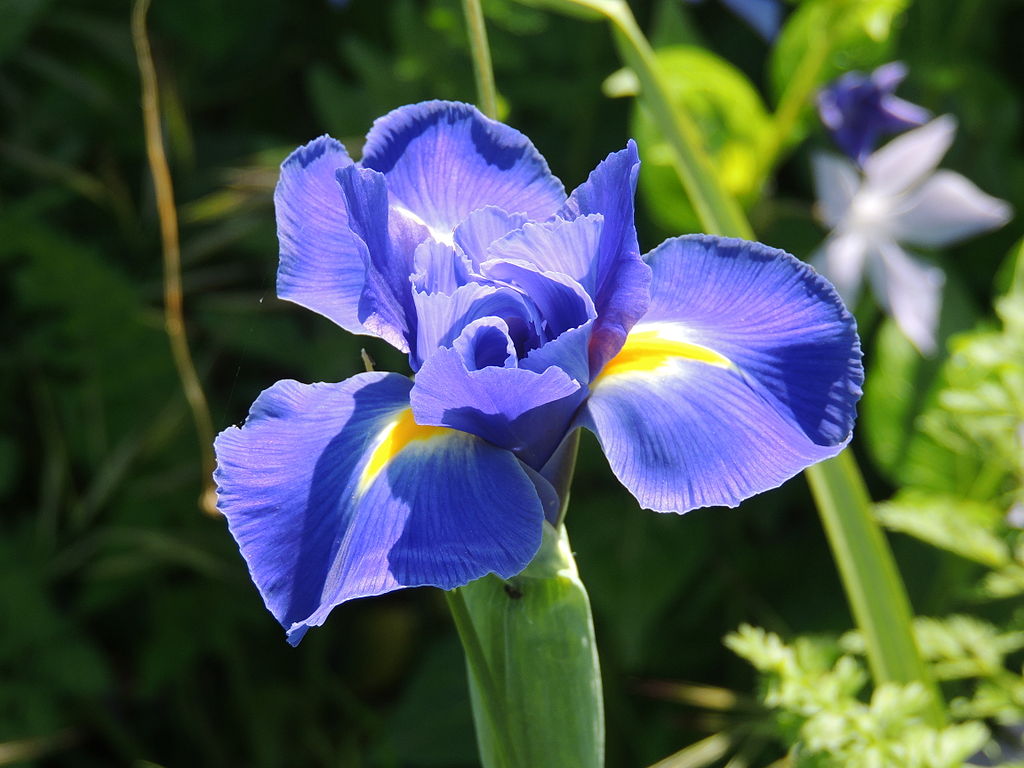 © Wikimedia.org/Roburq, CC BY-SA
© Wikimedia.org/Roburq, CC BY-SA
Echinacea /ˌɛkɪˈneɪʃiə/ is a genus of herbaceous flowering plants in the daisy family. It has ten species, which are commonly called coneflowers. They are found only in eastern and central North America, where they grow in moist to dry prairies and open wooded areas. They have large, showy heads of composite flowers, blooming in summer. The generic name is derived from the Greek word ἐχῖνος (ekhinos), meaning 'sea urchin', due to the spiny central disk. These flowering plants and their parts have different uses. Some species are cultivated in gardens for their showy flowers. Two of the species, E. tennesseensis and E. laevigata, are listed in the United States as endangered species. Echinacea purpurea is used in traditional medicine. Although commonly sold as a dietary supplement, there is insufficient scientific evidence that Echinacea products are effective or safe for improving health or treating any disease. (Source: Wikipedia.org, CC BY-SA)
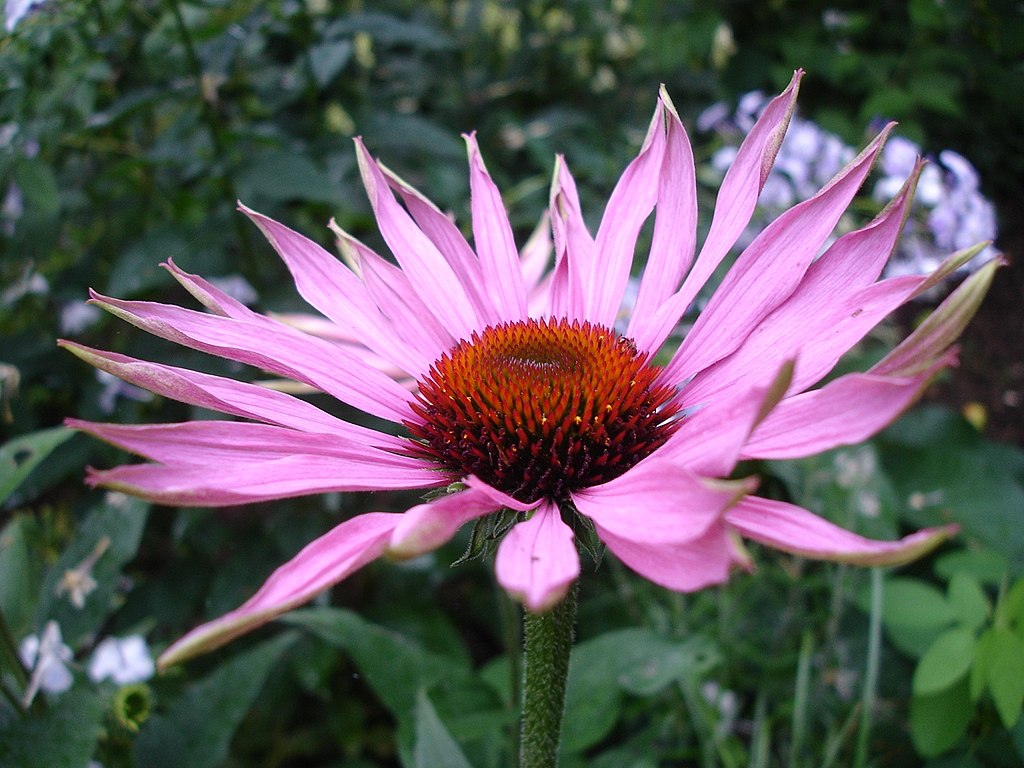 © Wikimedia.org/Ulf Eliasson, CC BY-SA
© Wikimedia.org/Ulf Eliasson, CC BY-SA
Echium /ˈɛkiəm/ is a genus of approximately 70 species and several subspecies of flowering plant in the family Boraginaceae. Species of Echium are native to North Africa, mainland Europe to Central Asia, and the Macaronesian islands where the genus reaches its maximum diversity. 29 species of Echium are endemic to the Canary, Madeira, and Cape Verde archipelagos. The continental species are herbaceous, whereas all but two of the endemic species of the Macaronesian islands are woody perennial shrubs. (Source: Wikipedia.org, CC BY-SA)
Hyacinthoides non-scripta /ˌhaɪəsɪnˈθɔɪdiːz nɒnˈskrɪptə/ (formerly Endymion non-scriptus or Scilla non-scripta) is a bulbous perennial plant, found in Atlantic areas from north-western Spain to the British Isles, and also frequently used as a garden plant. It is known in English as the common bluebell or simply bluebell, a name which is used in Scotland to refer to the harebell, Campanula rotundifolia. In spring, H. non-scripta produces a nodding, one-sided inflorescence of 5–12 tubular, sweet-scented violet–blue flowers, with strongly recurved tepals, and 3–6 long, linear, basal leaves. (Source: Wikipedia.org, CC BY-SA)
Erica is a genus of roughly 857 species of flowering plants in the family Ericaceae. The English common names heath and heather are shared by some closely related genera of similar appearance. The genus Calluna was formerly included in Erica – it differs in having even smaller scale-leaves (less than 2–3 mm long), and the flower corolla consisting of separate petals. Erica is sometimes referred to as 'winter (or spring) heather' to distinguish it from Calluna 'summer (or autumn) heather'. (Source: Wikipedia.org, CC BY-SA)
 © Wikimedia.org/Di Turner, CC0
© Wikimedia.org/Di Turner, CC0

Time for recess! Post a comment, ask a question or write a review. Feel free to let us know what you think!
look at the sign on the road to avoid accidents and horrible driving conditions
I received a 300$ ticket because I passed a police control of other cars/drivers on the right lane of a highway (the control was on the hard shoulder of the highway). Is it really true, that you have to change the lane in such cases? Thanks!
I am an American living in Italy. The Italian Drivers License theory test is the hardest test I have ever studied for and I am in my 70s have multiple degrees, multiple professional certifications. Have to take the Italian Drivers Theory test in Italian. No english. So many rules. More signs in small medieval Italian town I live in then in major US cities I have lived in. No Italian license no driving. No buying or renting a car. Test here was good, clean. Lots of tricky questions on many practice and real official tests. Thanks
Most problems are a result of higher than safe driving speeds. Please just slow down and be patient.
Question 121: Poor translation: Vehicles with polluted fluids prohibited Should be translated as: Vehicles with dangerous liquids prohibited
Question 83: Poor translation: Vehicles with polluted fluids prohibited Should be translated as: Vehicles with dangerous liquids prohibited
Want even more practice? Visit similar websites offering realistic practice driving knowledge tests. Visit us to see what sets our tests apart! https://dkttest.com/capital-territory/
Cool tool! And fun to check whether I remember the rules :) Two things I noticed: Warning for a crossroad side roads on the left and right. While technically that might be the correct translation, this sign tells you, that you are on the main road and have the right of way for the next crossroad and only the next crossroad. Usually (if no sign specifies otherwise) you have to give way to drivers coming from the right at every intersection, which can get a bit annoying in communal areas, so seeing this sign feels less like a warning and more like relief :). A Fahrradstraße is not a lane for cyclists but a street for cyclists, meaning the (whole!) street is intended predominantly for cyclists, who are then allowed to ride next to each other. Cars are allowed to drive there (unless another sign prohibits such), but have to adjust their speed to the cyclists. I believe they are not allowed to pass at all, even if the oncoming lane is empty.
More community